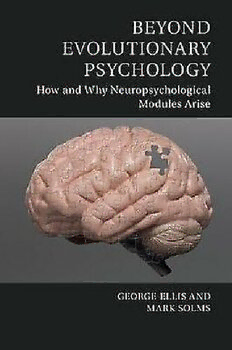
Beyond Evolutionary Psychology: How and Why Neuropsychological Modules Arise PDF
Preview Beyond Evolutionary Psychology: How and Why Neuropsychological Modules Arise
beyond evolutionary psychology The nature/nurture question is an age-old problem. Beyond Evolutionary Psychology deals with the relation between culture, evolution, psychology, and emotion,basedbothintheunderlyingbiology,determinedbyourevolutionary heritage, and in the interaction of our brain with the physical, ecological, and socialenvironment,basedinthekeypropertyofbrainplasticity.EllisandSolms show how the brain structures that underlie cognition and behaviour relate to each otherthroughdevelopmentalprocessesguidedby primaryemotional sys- tems.Thismakesveryclearwhichbrainmodulesareinnateor‘hard-wired’,and which are ‘soft-wired’ or determined through environmental interactions. The keyfindingisthattherecanbenoinnatecognitivemodulesintheneocortex,as this is not possible on both developmental and genetic grounds; in particular, therecanbenoinnatelanguageacquisitiondevice.Thisisessentialreadingfor studentsandscholarsofevolutionarypsychologyandevolutionarybiology. George Ellis is Emeritus Professor in the Mathematics Department at the University of Cape Town, and visiting Professor in the Physics Department, Oxford University. He co-authored The Large Scale Structure of Space-Time withStephenHawking.HehasbeenawardedtheStarofSouthAfricaMedalby President Nelson Mandela, the Order of Mapungubwe by President Thabo Mbeki,andtheTempletonPrize.Hehasmanyawards,includingsixhonorary doctorates,thelatestbeingawardedbytheUniversityofParis.Hislatestbook is How Can Physics Underlie the Mind? Top-Down Causation in the Human Context(2016). Mark Solms is a psychoanalyst and a professor in neuropsychology. He currently holds the Chair of Neuropsychology at the University of Cape TownandGrooteSchuurHospitalandisthePresidentoftheSouthAfrican Psychoanalytical Association. He is also currently Research Chair of the International Psychoanalytical Association and Science Director of the American Psychoanalytic Association. Solms founded the International Neuropsychoanalysis Society (with the late Jaak Panksepp) in 2000 and was aFoundingEditorofthejournalNeuropsychoanalysis.Hehaspublishedover 350articlesandchaptersandsevenbooks,thelatestbeingTheBrainandthe InnerWorld(2002,translatedinto13languages)andTheFeelingBrain(2015, hisselectedpapers).HeistheleadeducatorofthefreeonlinecourseWhatIsa Mind?ontheplatformFutureLearn. culture and psychology SeriesEditor DavidMatsumoto,SanFranciscoStateUniversity Asanincreasingnumberofsocialscientistscometorecognizetheperva- sive influence of culture on individual human behaviour, it has become imperativeforculturetobeincludedasanimportantvariableinallaspects of psychological research, theory, and practice. Culture and Psychology is anevolvingseriesofworksthatbringsthestudyofcultureandpsychology intoasingle,unifiedconcept. UteSchönpflug,CulturalTransmission:Psychological,Developmental, Social,andMethodologicalAspects EvertVandeVliert,Climate,Affluence,andCulture DavidMatsumotoandFonsJ.R.vandeVijver,Cross-CulturalResearch MethodsinPsychology AngelaK.-y.Leung,Chi-yueChiu,andYing-yiHong,CulturalProcesses:A SocialPsychologicalPerspective RominW.Tafarodi,SubjectivityintheTwenty-FirstCentury: Psychological,Sociological,andPoliticalPerspectives YairNeuman,IntroductiontoComputationalCulturalPsychology JohnW.Berry,MutualInterculturalRelations RonaldFischer,Personality,Values,Culture:AnEvolutionaryApproach Beyond Evolutionary Psychology How and Why Neuropsychological Modules Arise George Ellis UniversityofCapeTown Mark Solms UniversityofCapeTown UniversityPrintingHouse,Cambridgecb28bs,UnitedKingdom OneLibertyPlaza,20thFloor,NewYork,ny10006,USA 477WilliamstownRoad,PortMelbourne,vic3207,Australia 314–321,3rdFloor,Plot3,SplendorForum,JasolaDistrictCentre, NewDelhi–110025,India 79AnsonRoad,#06–04/06,Singapore079906 CambridgeUniversityPressispartoftheUniversityofCambridge. ItfurtherstheUniversity’smissionbydisseminatingknowledgeinthepursuitof education,learning,andresearchatthehighestinternationallevelsofexcellence. www.cambridge.org Informationonthistitle:www.cambridge.org/9781107053687 doi:10.1017/9781107283954 ©GeorgeEllisandMarkSolms2018 Thispublicationisincopyright.Subjecttostatutoryexception andtotheprovisionsofrelevantcollectivelicensingagreements, noreproductionofanypartmaytakeplacewithoutthewritten permissionofCambridgeUniversityPress. Firstpublished2018 PrintedintheUnitedKingdombyTJInternationalLtd.PadstowCornwall AcataloguerecordforthispublicationisavailablefromtheBritishLibrary. isbn978-1-107-05368-7Hardback isbn978-1-107-66141-7Paperback CambridgeUniversityPresshasnoresponsibilityforthepersistenceoraccuracyof URLsforexternalorthird-partyinternetwebsitesreferredtointhispublication anddoesnotguaranteethatanycontentonsuchwebsitesis,orwillremain, accurateorappropriate. contents ListofFigures pagevi ListofPlates viii Preface ix Acknowledgements xi 1 Introduction 1 2 TheMindandtheBrain 16 3 Hierarchy,Modularity,andDevelopment 38 4 ClaimsofInnateModularity 59 5 TheMindandEmotions 83 6 ARealisticViewofEvolution,Development,andEmotions 104 7 Conclusion 136 Appendix:LanguageInfinities 174 References 178 Index 195 Thecolourplatesectionappearsbetweenpages116and117 v figures 1.1 Thechainofcausation page6 2.1 Thetriunebrain 17 2.2 Thehypothalamus 20 2.3 Primaryandassociationcorticalareas 22 2.4 Thetectum 24 2.5 Thehippocampus 26 2.6 Thepowerofillusion 30 2.7 Thethalamus 31 2.8 Corticothalamiccircuitry 31 2.9 Broca’sareaandWernicke’sarea 33 3.1 Hierarchicalstructureofthecentralnervoussystem 39 3.2 Connectionsofneuronsviasynapses 41 3.3 Top-downeffectsoncellfunctionandgeneexpression 45 3.4 Neuralnetworkmodel 47 3.5 Thechainofdevelopmentalcausation 51 4.1 Mappingsfromobjectsormentalactivitytoconcepts towords 64 4.2 Theshortroutefromthegenometocognition 73 4.3 Thelongerroutefromthegenometocognition 73 5.1 Periaqueductalgreymatter(PAG) 86 5.2 TheSEEKINGsystem 90 5.3 TheRAGEsystem 93 5.4 TheFEARsystem 94 5.5 ThePANIC/GRIEFsystem 97 5.6 Theeffectivenessofplacebos 102 6.1 Theinteractionsbetweenevolution,development,structure, function,andenvironment(context) 107 vi ListofFigures vii 7.1 Theancientenvironmentselectsdevelopmentalsystemsthat provideddesirableoutcomesinthatcontext 140 7.2 Thewayconsciousproblem-solvingroutinesgetembodiedin intuitiveproblem-solvingpatterns 149 7.3 Spokenandwrittenlanguagesaredifferentinstantiations ofthesameexpressionsrepresentingabstractconcepts 158 plates 1 Thenervoussystem 2 (a)Cortexstructure(left),(b)ascendingsystems(right) 3 (a)Theoptictract,(b)theretinalsynapticconnections 4 SomemajornucleiofthereticularactivatingsystemandPAG 5 Associationareas 6 Thevisualwordformarea 7 Semanticmodels:Principalcomponentsofvoxel-wisesemantic models,revealingfourimportantsemanticdimensionsinthebrain 8 Physicaldomainsinthecortex 9 Hierarchicalstructureofageneregulatorynetwork 10 (a)Sketchofcorticalcolumnsmadeupofinterconnectedneurons, (b)Detailedmicrosketchofcorticalcolumns 11 Thenucleusaccumbens viii preface A profound question regarding brain/behaviour relationships is this: which aspects are innate, that is, are essentially genetically determined, andwhich arenot?Thatis,whichaspectshaveaninitialstructurethatis genetically determined but rather loosely prescribed at a detailed level, their detailed nature then being precisely determined through develop- mentalprocessesasaconsequenceoflearningexperiencesandinteraction with the environment? Major disputes have raged around this question, withmanylinguistssupportingChomsky’sproposalsconcerningtheexis- tenceofinnatelanguagemodulesinthebrain,andwithsomeevolutionary psychologists recently claiming existence of many other innate cognitive modules,evenmodulesforfolkpsychology,folkbiology,andfolkphysics. An opposing school, largely composed of ‘evo-devo’ theorists, have stronglydeniedtheseclaims. In our view, this dispute can only be resolved through a more detailed consideration of the specific brain structures that are innate in the above sense,thusavoidingsweepingstatementsaboutthebrainasawhole,asis thecommonpractice.Suchdetailedconsiderationmusttakeseriouslyboth neurophysiology and developmental neurobiology, based in epigenetic processes, instead of simply relying on theoretical speculations about the evolutionaryoriginsofbehaviour. We argue that when this is done, a rather clear picture emerges as to whichbrainstructuresareinnate,or‘hard-wired’,andwhicharenot.That isthetopicofthisbook. The conclusion is to recognize a number of brain modules that are indeedhard-wired,butthesemodulesexcludethewholeoftheneocortex. If correct, this book shows that the existence of innate language modules andotherinnatecognitivemodulesisnotbiologicallyplausible.Rather,we argue that any and all cognitive modules must have essentially ix
